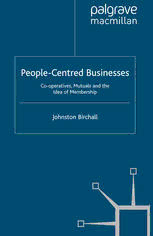
People-Centred Businesses: Co-operatives, Mutuals and the Idea of Membership PDF
Preview People-Centred Businesses: Co-operatives, Mutuals and the Idea of Membership
People-Centred Businesses Also by Johnston Birchall BUILDING COMMUNITIES, THE CO-OPERATIVE WAY CO-OP: The People’s Business CO-OPERATIVES AND THE MILLENNIUM DEVELOPMENT GOALS DECENTRALISING PUBLIC SERVICE MANAGEMENT (with C Pollitt) REDISCOVERING THE COOPERATIVE ADVANTAGE: Poverty Reduction Through Self-help THE INTERNATIONAL CO-OPERATIVE MOVEMENT Also edited by Johnston Birchall HOUSING POLICY IN THE 1990s THE NEW MUTUALISM IN PUBLIC POLICY People-Centred Businesses Co-operatives, Mutuals and the Idea of Membership Johnston Birchall Professor of Social Policy, Stirling University © Johnston Birchall 2011 Softcover reprint of the hardcover 1st edition 2011 978-0-230-21718-8 All rights reserved. No reproduction, copy or transmission of this publication may be made without written permission. No portion of this publication may be reproduced, copied or transmitted save with written permission or in accordance with the provisions of the Copyright, Designs and Patents Act 1988, or under the terms of any licence permitting limited copying issued by the Copyright Licensing Agency, Saffron House, 6–10 Kirby Street, London EC1N 8TS. Any person who does any unauthorized act in relation to this publication may be liable to criminal prosecution and civil claims for damages. The author has asserted his right to be identified as the author of this work in accordance with the Copyright, Designs and Patents Act 1988. First published 2011 by PALGRAVE MACMILLAN Palgrave Macmillan in the UK is an imprint of Macmillan Publishers Limited, registered in England, company number785998, of Houndmills, Basingstoke, Hampshire RG21 6XS. Palgrave Macmillan in the US is a division of St Martin’s Press LLC, 175 Fifth Avenue, New York, NY 10010. Palgrave Macmillan is the global academic imprint of the above companies and has companies and representatives throughout the world. Palgrave® and Macmillan® are registered trademarks in the United States, the United Kingdom, Europe and other countries ISBN 978-1-349-30379-3 ISBN 978-0-230-29529-2 (eBook) DOI 10.1057/9780230295292 This book is printed on paper suitable for recycling and made from fully managed and sustained forest sources. Logging, pulping and manufacturing processes are expected to conform to the environmental regulations of the country of origin. A catalogue record for this book is available from the British Library. A catalogue record for this book is available from the Library of Congress 10 9 8 7 6 5 4 3 2 1 20 19 18 17 16 15 14 13 12 11 For Bernadette This page intentionally left blank Contents List of Tables viii 1 People-Centred Businesses 1 2 Theorising the Rise and Fall of Member-owned Businesses 20 3 Consumer-owned Retail Businesses 43 4 Consumer-owned Insurance Providers 65 5 Consumer-ownership of Housing 90 6 Consumer-ownership in Public Services and Utilities 106 7 Consumer/Producer-owned Banks 126 8 Producer-owned and Employee-owned Businesses 154 9 The Peculiar History of ‘Member-owned’ Businesses in 179 Developing Countries 10 The Idea of Membership 205 Bibliography 211 Index 221 vii List of Tables 1.1 A suggested taxonomy of member-owned businesses 5 2.1 Some important questions 22 2.2 Theories that explain why co-operatives succeed or fail 32 2.3 Some periods in the life of a MOB sector 39 7.1 Differences between the Schulze-Delitzsch and Raiffeisen 138 systems 7.2 Credit union statistics, comparing the years 2000 and 148 2008 8.1 Proportion of employees who are owners, by whether 170 outside investors are also owners viii 1 People-Centred Businesses We are at the Treasury in Whitehall. I sit at a very large table with a group of chief executives discussing corporate governance. From where I am sitting I can see St James’s Park and, through a rear window, the roofs of several government ministries. I am among powerful people in a powerful place; they are the top people in the worlds of banking and insurance, and they have been invited by the government to share their views on how financial services com- panies should be governed. There is an air of expectation; civil servants sit to one side recording every nuance of our conversation. We discuss several issues to do with good governance, including the old controversy over whether the European tradition of having a supervisory board and a management board is superior to the British and American tradition of having just one unified board. We spend some time discussing the kinds of skills board members need in order to be effective. This is a few years before the global banking crisis, but we have a sharp discussion about risk and whether board members can assess the risks their managers are taking. We get on to the subject of executive and non-executive directors, the point at issue being how many of each a board should have if it is to be effective. The general opinion seems to be that there should be a balance, but some lean towards having more exec- utive directors on the board than non-executives. This means they want the managers of the company to be in control rather than the owners. I find this idea quite alarming, but say nothing. They take it in turns to describe how their own companies deal with this issue. The recently retired chief executive of a large life insur- ance company explains ‘In our company we have a tradition that ‘non-execs’ are in the majority on the board. I don’t know why’. 1
